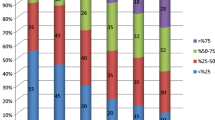Summary
Introduction. Vagus nerve stimulation is a novel treatment for patients with medically refractory epilepsy, who are not candidates for conventional epilepsy surgery, or who have had such surgery without optimal outcome. To date only studies with relatively short follow-up are available. In these studies efficacy increased with time and reached a maximum after a period of 6 to 12 months. Implantation of a vagus nerve stimulator requires an important financial investment but a cost-benefit analysis has not been published.
Patients and Methods. Our own experience with VNS in Gent comprises 15 patients with mean age of 29 years (range: 17–44 years) and mean duration of epilepsy of 18 years (range: 4–32 years). All patients underwent a comprehensive presurgical evaluation and were found not to be suitable candidates for resective epilepsy surgery. Mean post-implantation follow-up is 24 months (range: 7–43 months). In patients with follow-up of at least one year, efficacy of treatment in terms of seizure control and seizure severity was assessed one year before and after the implantation of a vagus nerve stimulator. Epilepsy-related direct medical costs (ERDMC) before and after the implantation were also compared.
Results. A mean reduction of seizure frequency from 14 seizures/month (range: 2–40/month) to 8 seizures/month (range: 0–30/month) was achieved (Wilcoxon signed rank test n=14; p=0.0016). Five patients showed a marked seizure reduction of ≥50%; 6 became free of complex partial seizures, 3 of whom became entirely seizure free for more than 12 months; 2 patients had a worthwhile reduction of seizure frequency between 30–50%; in 2 patients seizure frequency reduction has remained practically unchanged. Seizure freedom or ≥50% seizure reduction was achieved within the first 4 months after implantation in 6/11 patients. Before the implantation, the mean yearly epilepsy-related direct medical costs per patient were estimated to be 8830US$ (n=13; range: 1879–31129US$; sd=7667); the average number of hospital admission days per year was 21 (range: 4–100; sd=25.7). In the 12 months after implantation, ERDMC had decreased to 4215US$ (range: 615–11794US$; sd=3558) (Wilcoxon signed rank test n=13; p=0.018) and the average number of admission days to 8 (range: 0–35) (Wilcoxon signed rank test n=13; p=0.023).
Conclusion. VNS is an effective treatment of refractory epilepsy and remains effective during long-term follow-up. Cost-benefit analysis suggests that the cost of VNS is saved within two years following implantation.
Similar content being viewed by others
Author information
Authors and Affiliations
Rights and permissions
About this article
Cite this article
Boon, P., Vonck, K., Vandekerckhove, T. et al. Vagus Nerve Stimulation for Medically Refractory Epilepsy; Efficacy and Cost-Benefit Analysis. Acta Neurochir (Wien) 141, 447–453 (1999). https://doi.org/10.1007/s007010050324
Issue Date:
DOI: https://doi.org/10.1007/s007010050324




